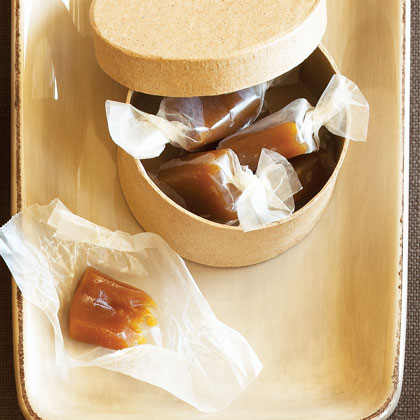Butterscotch Caramels

How to Make It
Butter an 8- by 8-in. disposable aluminum pan and set on a baking sheet.
In a 5- to 6-qt. saucepan over medium-low heat, use a heatproof spatula to stir together 3/4 cup butter, the corn syrup, brown sugar, cream, lemon juice, salt, and 1/2 cup water until butter is melted and sugar is completely dissolved (see "Caramelizing Sugar: Watch Closely," below). Increase heat to medium and bring mixture to a simmer. Cook, stirring occasionally, until mixture is golden brown and measures 240° to 245° on a candy thermometer (see "Using a Candy Thermometer", below), 15 to 20 minutes. Remove from heat and carefully stir in vanilla (mixture will bubble up). Immediately pour caramel into prepared pan. Chill until firm enough to cut, about 2 1/2 hours.
Remove from pan (see Notes) and use a large, sharp knife to cut caramel into 1-in. squares. Wrap each piece (see Notes) and store in an airtight container in the refrigerator for up to 2 weeks. Bring to cool room temperature before eating.
Caramelizing sugar: Watch closely. Sugar cooks quickly once it begins to brown, so have your ingredients measured and your tools assembled before you start. Before bringing your sugar mixture to a boil, make sure you completely dissolve the sugar and melt the butter: Stir the mixture with a flexible heatproof spatula over medium-low heat, running the spatula around the inside of the saucepan a few times to thoroughly mix everything together.
Using a candy thermometer
It can be tricky to know when a sugar mixture has reached the temperature that will yield the texture you're after. Thankfully, candy thermometers eliminate the guesswork. You'll find them at supermarkets and some hardware stores; make sure to choose one that measures temperatures up to 400°.
Test it first: If you have an old thermometer in the back of your gadget drawer, test its accuracy by immersing it in boiling water; it should read 212°. (If it doesn't, get a new thermometer.) Our favorite in the test kitchen is the Taylor Classic Candy and Deep-Fry Analog Thermometer ($13; available at housewares and home improvement stores), an inexpensive model that's easy to read and attaches securely to the pan's side.
Read it accurately: Attach the thermometer to the side of the pan after the sugar mixture has come to a boil. The placement of the heat sensor varies among brands, but generally the bottom of the thermometer must be completely submerged in the sugar mixture to get an accurate reading. If the mixture is too shallow, carefully tilt the pan until liquid completely covers the bottom of the thermometer when you want to check the temperature.
Note: Nutritional analysis is per caramel.
Ingredients
Directions
Butter an 8- by 8-in. disposable aluminum pan and set on a baking sheet.
In a 5- to 6-qt. saucepan over medium-low heat, use a heatproof spatula to stir together 3/4 cup butter, the corn syrup, brown sugar, cream, lemon juice, salt, and 1/2 cup water until butter is melted and sugar is completely dissolved (see "Caramelizing Sugar: Watch Closely," below). Increase heat to medium and bring mixture to a simmer. Cook, stirring occasionally, until mixture is golden brown and measures 240° to 245° on a candy thermometer (see "Using a Candy Thermometer", below), 15 to 20 minutes. Remove from heat and carefully stir in vanilla (mixture will bubble up). Immediately pour caramel into prepared pan. Chill until firm enough to cut, about 2 1/2 hours.
Remove from pan (see Notes) and use a large, sharp knife to cut caramel into 1-in. squares. Wrap each piece (see Notes) and store in an airtight container in the refrigerator for up to 2 weeks. Bring to cool room temperature before eating.
Caramelizing sugar: Watch closely. Sugar cooks quickly once it begins to brown, so have your ingredients measured and your tools assembled before you start. Before bringing your sugar mixture to a boil, make sure you completely dissolve the sugar and melt the butter: Stir the mixture with a flexible heatproof spatula over medium-low heat, running the spatula around the inside of the saucepan a few times to thoroughly mix everything together.
Using a candy thermometer
It can be tricky to know when a sugar mixture has reached the temperature that will yield the texture you're after. Thankfully, candy thermometers eliminate the guesswork. You'll find them at supermarkets and some hardware stores; make sure to choose one that measures temperatures up to 400°.
Test it first: If you have an old thermometer in the back of your gadget drawer, test its accuracy by immersing it in boiling water; it should read 212°. (If it doesn't, get a new thermometer.) Our favorite in the test kitchen is the Taylor Classic Candy and Deep-Fry Analog Thermometer ($13; available at housewares and home improvement stores), an inexpensive model that's easy to read and attaches securely to the pan's side.
Read it accurately: Attach the thermometer to the side of the pan after the sugar mixture has come to a boil. The placement of the heat sensor varies among brands, but generally the bottom of the thermometer must be completely submerged in the sugar mixture to get an accurate reading. If the mixture is too shallow, carefully tilt the pan until liquid completely covers the bottom of the thermometer when you want to check the temperature.
Note: Nutritional analysis is per caramel.

